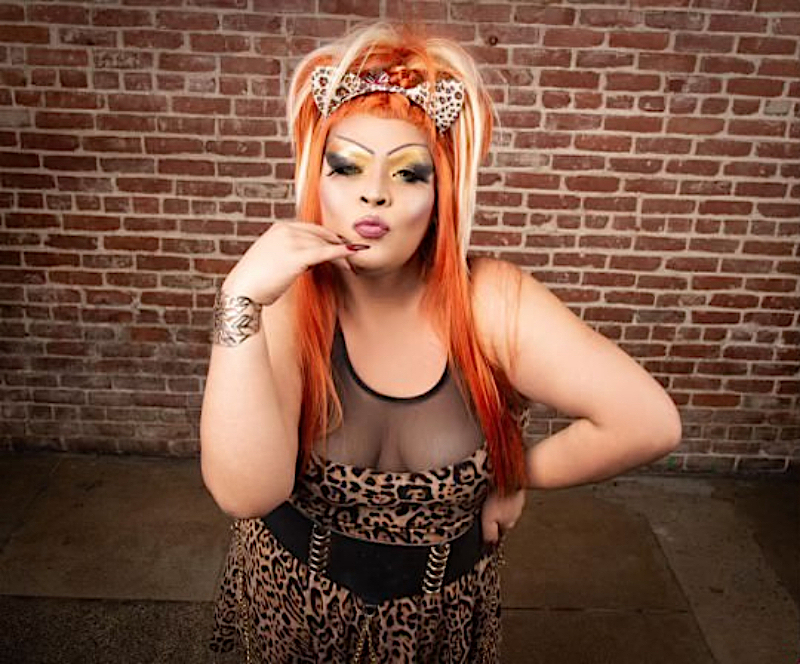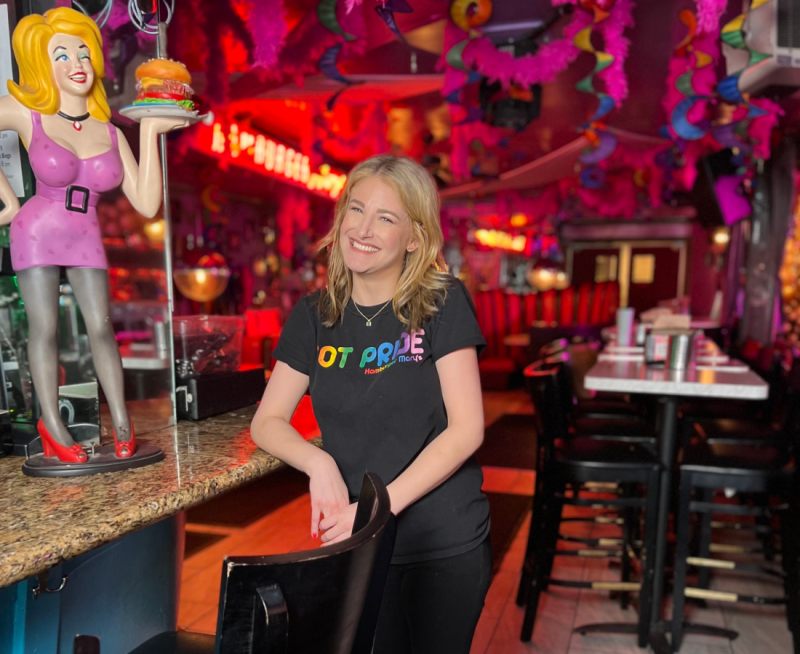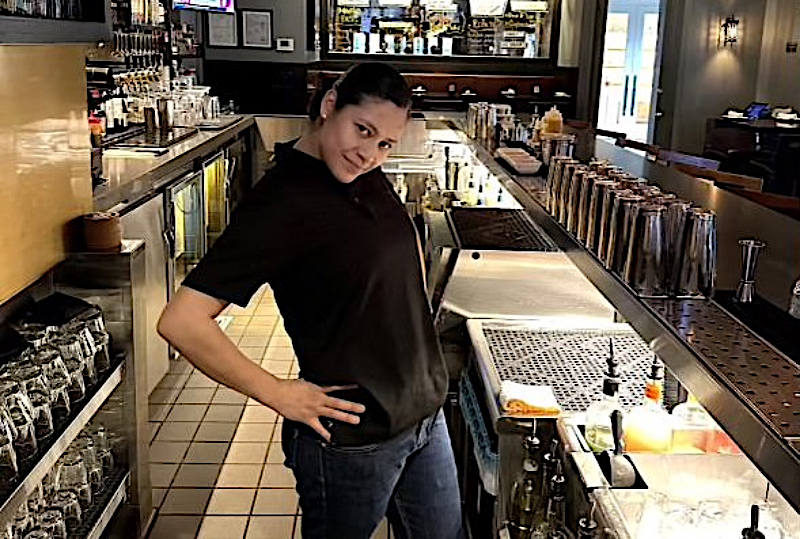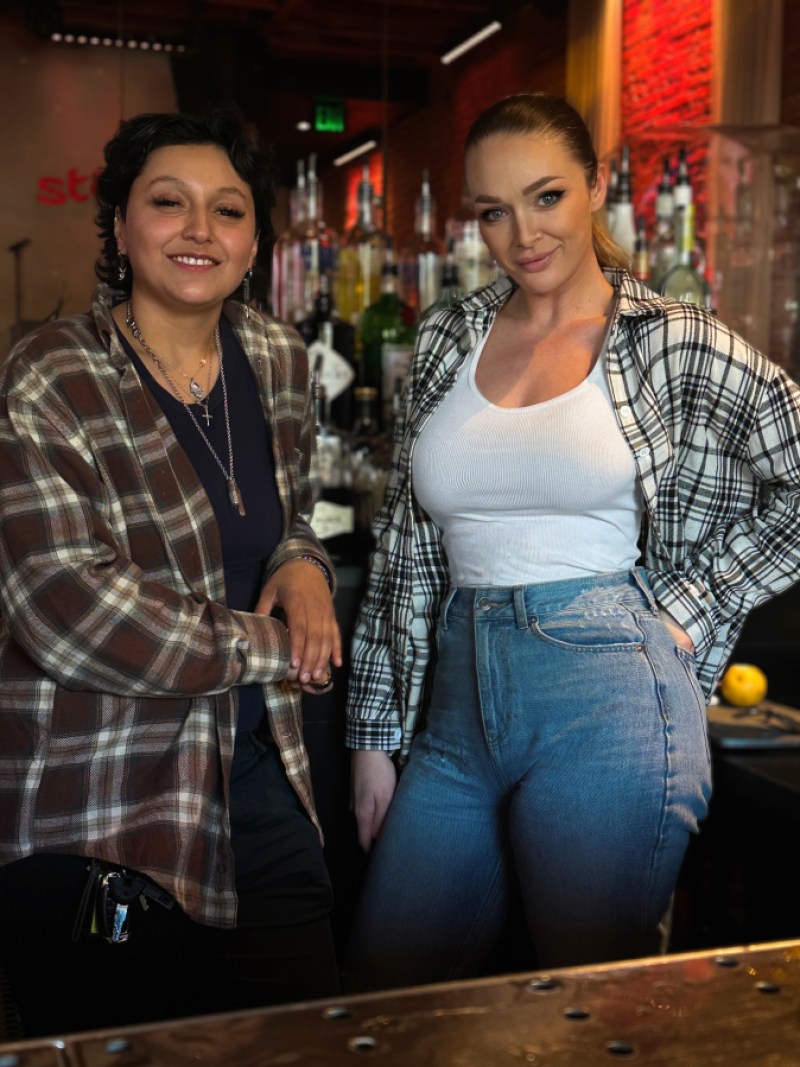When Katrina Marie Nunez got promoted from barback to bartender at Gym Sportsbar and Grill, she became the first openly trans woman to tend bar in West Hollywood, California.
The area, nicknamed “WeHo,” is a classic boystown. Gym Bar sits right on the corner of a competitive block of gay bars, shops, and restaurants on Santa Monica Boulevard. The bartenders are predominately cis, male, white, jacked, and thus, ready to peddle potent $20 cocktails to horny customers. It’s like a mini Vegas with drag queens instead of Elvis impersonators.
There’s a bar for every type: Motherlode, a hub for the flirty older crowd. Rocco’s, dancey and partially owned by former boybander Lance Bass. Bayou, a slim dark bar known for its colorful syringe jello shots. HiTops, decorated to look like a gym locker room. The list goes on and on.
But there are no specifically lesbian bars in West Hollywood. In Los Angeles, lesbians typically spend their nightlife on the eastside in neighborhoods with dedicated queer women spaces like Honey’s and The Ruby Fruit.
In the 1970s, lesbian historian Lillian Faderman described WeHo as sexist, racist, and exclusive. Even men couldn’t get into the discos unless they were “good-looking,” “generally white” and “middle-class,” Faderman noted. Women, to get into those same clubs, had to show five pieces of identification. “Which is ridiculous,” Faderman said. “So, women got the idea that they were not welcome.”
“There are some places that, yeah, you feel like you don’t fit in because you don’t look a certain way or you’re not richer. Stuff like that,” Nunez agreed. “It’s so weird that you feel uncomfortable in a place where it’s supposed to be welcoming. Where they say, ‘Oh, we welcome everyone!’ But do you really?”
Weeks ago, I struck up a conversation with Nunez, not just because we’re both trans, but because I’d seen very few female bartenders in West Hollywood. The number of women patrons has noticeably grown since I moved there a year and a half ago. But on two separate scouting missions last week, I failed to find one woman working behind a bar anywhere on the street.
So when Nunez got promoted to front of house, she was nervous. “I didn’t really have a big cheering section other than my coworkers here,” she said. Her manager even pulled me aside during our interview to rave about her, but Nunez worried that the largely cis, white, gay male clientele wouldn’t warm to her. Some have told her she doesn’t belong in “their bars.”
It was also a financial risk for Gym’s management to promote a trans woman, particularly Nunez said, a trans woman of color, to such a customer facing position. Rent is rising on the boulevard, with bars closing left and right post-2020. (For example, the country western spot Flaming Saddles has sat abandoned for three years, a two-story cautionary tale.) If owners hire a bartender, even in 2024, who doesn’t meet Faderman’s observed 70s requirements, “they don’t know if it’s going to work,” Nunez said.
But Nunez, with her dark hair and lashes, who also moonlights as the drag queen Ms. KittyKat, had put in her hours over the past two years. Her visibility was important to her, her bosses, and to an area that has had to embrace greater gender inclusivity in hiring – for it’s own fucking good.

Katrina Marie Nunez, bartender at Gym Sportsbar and Grill (photo by Jonathan Cottrell)
Along with Nunez, I spoke to Allie Cavanagh, a friendly cis bisexual woman behind the bar at the nightclub Stache. (She always lets you taste your cocktail before charging you); Cavanagh’s co-worker, the newly hired Ericka “Kobe” Bernal, a masc lesbian who got her nickname playing basketball in high school; Cheyanne Dunn, the bar manager at the drag bar Hamburger Mary’s, who describes herself as a “femme bisexual blonde with big boobs”; and Alexandra Rauda, a cis lesbian “with a rough exterior” who bartends at the very florally decorated Arden.
The rest of the female bartenders in WeHo can be counted on one hand.
Like Nunez’s barrier breaking hire, Dunn has been told she’s the first female bartender Mary’s has employed in a decade. For her first nine months, she was the bar’s only female employee.
Before getting hired at Mary’s – a franchise drag bar known for its weekend drag brunches – three years ago, Dunn had spent very little time in West Hollywood – visiting maybe three times in the six years she’s lived in LA. “It took me a long time to get to the place of being comfortable being this woman bartender in WeHo,” Dunn said. Mary’s is also a ways down Santa Monica, somewhat separated from the main strip, but since it’s well-known, the area around it is often packed.
She’s contended with gay male customers nicknaming her “the token vagina.” She said she would have preferred “literally anything else” over that moniker.
But it has gotten better. A year ago, Dunn said, the drag queen hosts would ask for the demographics of the crowd and only one or two women would cheer for being queer. But now, she says, that number (and noise) has markedly increased.
“Or maybe I’m just noticing them more,” she joked. (Full disclosure: Dunn is my sister, so of course she’s scouting for hotties.)

Cheyanne Dunn, bartender at Hamburger Mary’s (photo by Jerry Plummer)
Nunez said she’s noticed more female clientele who said they came in because they saw a woman behind the bar, as well as more trans customers of all kinds. If they’re using IDs with their deadnames or old photos, Nunez said they are excited to come in when they notice she’s working.
“There are trans women who don’t want to show their ID still because it’s not their face,” she said, so she looks at the card and tells them, “You’re so beautiful!. Just gorgeous!” The word spreads that they won’t be hassled at Gym.
Masc women have done the same thing to Stache’s Bernal, one of the few masc lesbians working behind the bar in WeHo. She and her co-worker, the more femme-presenting Cavanagh, have each been told by other employees – and by the customers themselves – that their female presences have been welcoming to all genres of ladies. Stache’s bartop is one of the few directly visible from the street.
It’s been nice popping my head through the little fence of bushes and seeing Bernal or Cavanagh. When the rest of Santa Monica Blvd is male bartenders, male dancers, and male patrons, seeing them sends a message it sometimes means to – and sometimes doesn’t mean to – send: We see you in here. As a trans guy, I was read as a butch woman when I first started partying in the area and back then, it was definitely harder to grab the bartenders’ attention.
“I have heard lesbians before say that they feel like gay men don’t care about them,” Cavanagh lamented. “They think that they judge them, and they think that they look right past ’em or over them.”
She thinks the area could stand to be a little more open to the girls.
THE DOWNSIDES
Having worked in “straight” restaurants for over a dozen years, Dunn said she noticed that at gay male bars the words “bossy” and “bitchy” are thrown at her way more.
In WeHo, “it’s a lot of having to navigate the very strong gay personalities of the men and find where my sort of, not my place, but where I can get my voice in,” she said. When she worked in more mixed gender bars in more mixed gendered neighborhoods, she said she was never called “bossy” or “bitchy” by co-workers or clients. But being a woman stands out here. It helps though that anyone who’s had a problem with her hasn’t lasted long working at Mary’s. (Like Nunez, her coworkers have her back.)
And Nunez too has dealt with that particular insult: “bitch.”
“I have been called a fat bitch. A dumb bitch. An ugly bitch,” she said of times when she’s had to deny drinks to severely intoxicated customers. “And I’m like, I’m just telling you for your safety. You can’t come in. …And they’re like, ‘oh, you’re just a bitch. I don’t know why they let bitches work the door.’” (“Bitch,” she later tells me, is reserved for friends only.)
And then, there’s the issue of contending with the specific kinds of straight people who come to West Hollywood. Over the last couple years, Cavanagh has noticed an increase in heterosexual couples. She doesn’t mind it, but she and her co-workers can clock when it’s going to be a “straight night.” When I point out maybe the couples are bisexual women and their boyfriends, Cavanagh said it’s possible but the women, if also queer, haven’t been as friendly to her as the ones she identifies as queer off the bat. The confusion of straight culture and gay culture can lead to misunderstandings like this one:
“I call my customers, I’ll say ‘babe’ or whatever. It’s nothing. It’s just the term of endearment and just talking to people and taking orders,” Cavanagh said. “And the other night there was this guy and I said, ‘what can I get you, babe?’ And then the girl he was with gave me this look, and I said, ‘Oh, he’s straight. And that’s his girlfriend.’ And ‘Oh my god, I’ve offended her now.’”
Cavanagh tried to cover by calling the girl “babe” as well, but the miffed customer still believed the bartender was flirting with her boyfriend.
Bachelorette parties, and other gaggles of straight women going out to gay bars is nothing new. But now it’s providing an open invitation to straight men, a source of recent discourse online when a Tiktok about straight men at New York’s lesbian bar Cubbyhole went viral.
Before she worked in the area, Nunez used to go out in WeHo as a woman, thankful to not get hit on. Now, she’s noticed more straight men unexpectedly chatting her up, even while she’s working behind the bar. Then, she feels like she has to out herself in a place where she should feel safe being LGBTQ.
“I’m just like, ‘Son of a bitch, no.’ It’s like, ‘No, I’m a trans woman.’ I’m like, ‘Dude I’m not what you’re looking for. I have a penis, please leave.’” She laughed. “If you’re into that, we can talk. You can stay, but if you’re not, you need to walk away.”
Entitled straight men have also put their hands on Dunn when she’s at work at Mary’s thinking she’s an easy target for being a unsuspecting “straight girl” working at a gay bar. (She said she likes to stare them down and simply ask, “Why would you think that?” while watching them stumble over their words.)
“Straight men know where the straight girls are going. So it’s no longer a place to hide anymore,” Nunez said. “[Straight women’s] safety makes us unsafe.”
THE UPSIDES
There are plenty of positives to being a woman working the bars in WeHo. Her time at Stache is what helped Cavanagh come out as bisexual. She’d never thought about her sexuality much, but her co-workers began asking and upon recounting her history, she realized she was also open to women. At her previous jobs at straight bars, everyone was assumed to be straight so she’d never felt free enough to have that sort of conversation at work.
“WeHo is a little bit more open and people are proud and they ask. And so it was a whole new world to me, which I loved,” Cavanagh said. “It was definitely something that was different, but in a great way, in the best way.”
Rauda, who started working at Arden five months ago, has also felt pretty welcome amongst the gay men.
“I know I wear men’s clothes, but I’m very in touch with my feminine side,” Rauda said. “Everybody always tells me, if anything, you’re like, a lesbian, but a gay man.”

Alexandra Rauda, bartender at Arden
Bernal also feels the love – more than she thinks a femme woman might. “A lot of the guys think I’m cute too because I have that masc look,” she laughed. “None of them are serious, but I always compliment them back and flirt with them back.”
A few of the women I interviewed said there’s way less physical fighting happening at the WeHo bars. Cavanagh said WeHo is where she’s seen the least bar fights in her entire career as a bartender. At bars in other neighborhoods, “someone’s getting thrown into a wall” every weekend, she said. But the gay guys she serves now are “kind, loving and happy.” Security rarely has to manhandle anyone out of Stache.
Rauda is worried a lesbian bar would ruin that peace. The LGBTQ sexual scene has too much crossover, she said. For gay men that’s all fine and dandy, but lesbians get territorial and start throwing elbows.
“I feel like [a lesbian bar] would be mayhem,” Rauda told me on the phone as I fell to my kitchen floor laughing. “Oh, you see that woman with another woman?,” Rauda imagined lesbians gossiping to each other. “Oh my God, I was just with her last week!”
And then? More fist fights than the strip has ever seen before. I kept laughing but Rauda was mostly serious: “That would be pretty scary, to be honest with you!”
WHERE DO THE LESBIANS HANG OUT?
So what’s the future for women in West Hollywood now that more female bartenders are being hired? A dedicated lesbian bar.
“WeHo needs a girl bar,” Nunez said. Plain and simple. She told me she just read about a lesbian-owned establishment called Sweetwater which is coming to the strip, possibly over the summer. According to the WeHo Times, the bar is being opened by Berni Gambino, a lesbian and former West Hollywood deputy sheriff. (Lesbian god giveth and lesbian god taketh away.)
The comments on the article about the new gay girl spot are largely positive with only minimal complaining about the use of “inclusive” instead of “gay” to describe a West Hollywood bar and something incomprehensible about “boys town” “ending” because of “pronouns.”
“It is kind of sad, because I’m frequently asked as a lesbian worker at Stache, you know, where’s the queer women place,” Bernal said. “I have nothing to tell them or to recommend, especially on the weekends, because nothing is done for women on the weekends.”
She’s referring to Chapel, a subsection of the infamous gay club The Abbey, that hosts a night for queer women on Wednesdays. It’s the only mainstay lesbian event on the strip. I attended pre-transition and found it to be mostly cis women, mostly femme. A shocking amount of YouTube lesbians. Nunez, who is bisexual, said she’s attended Chapel before but finds it too loud in there to really get to know other women.
Cavanagh said some lesbian nights have been pitched at Stache, but not approved. “I’ve had old coworkers in the past tell me that the lesbians don’t drink enough,” she said. “…it seems like they don’t think it’s going to be a big money making night.” The bar did host a Superbowl party this year run by a women’s group and that actually brought more paying lesbians.

Ericka “Kobe” Bernal and Allie Cavanagh, bartenders at Stache (photo by Sebastian LaCause)
Sports are a running theme. (Pun intended.) When Nunez is working, she purposefully puts women’s soccer and basketball games on the TVs to entice “the sporty girls.” (A very good euphemism for lesbians.) At one such women’s sports viewing event at Gym, she watched two gay male regulars peek in, see only groups of women inside, and straight up leave.
“It’s just hard because sometimes you’ll have a lot of the older gays who are just like, this is a gay bar. This is a boy bar,” she said. “But not really because I’d rather have a group of 20 lesbians in here buying, drinking beer and partying than have two rich men here. Because you’re only going to drink two or three drinks. The girls are going to drink way more.”
Bernal makes the excellent point that just because there’s one night or one bar “for women” doesn’t mean it appeals to all women. Why do the gay men get to choose the theme of the WeHo bar they want to go to, but lesbians just have “lesbian?” It limits who the patrons might be. Femmes and mascs, for instance, might have different tastes.
The bar Rauda works for, Arden, really promotes their Instagrammable flower walls and “enchanted garden” vibes. Arden tends to get more “pretty women” in, Rauda said, because they want to take photos with delicate social media friendly backgrounds. Whether those women are queer, Rauda doesn’t know. But she sees more women at Arden than other WeHo bars. It’s also a 15 minute walk away from the meat market of the strip, and thus less chaotic to go to.
The new girl bar Sweetwater will be wedged right in the middle of the Santa Monica Blvd scene.
“We’re always saying we don’t have a place to go, and so if this place opens up and it doesn’t stand for long, that’s on us,” Bernal said. “The girls, we need to come out!”
She’s right. I also asked, instead of putting all our eggs into a former cop’s lesbian bar basket, how can WeHo make itself more holistically appealing to queer women?
Rauda thinks more than another bar, a lesbian coffee shop, like The L Word’s The Planet, would bring more queer women to WeHo. It would stand out, and provide a place to hang during the day for women who don’t want to party at night.
Dunn thinks more women working the doors and more female go-go dancers would serve as advertisements for a bar’s inclusivity. Maybe too, she said, diversifying the playlists. The music at the bars can be extremely loud and incredibly repetitive. To bring more queer women to WeHo, clubs could rotate their records.
“There’s a few where I’m like, oh no, if I hear this again, I’m going to kill someone,” Dunn said, referencing “Dancing Queen,” Megan’s “Body-Ody-Ody,” and Britney mixes. For months, if she heard Jennifer Lopez’s “Let’s Get Loud” while she was out somewhere else, she would get up and leave. My own friends have a joke where whenever the bars play Flowers by Miley Cyrus we act like we’ve never heard it before – because we’ve heard it hundreds of times.
But for any changes to happen, the higher ups have to agree to make those changes. Bernal’s recommendation is not to her fellow bartenders, but to the owners of the bars: If your female employee has a pitch for an event or promotion to bring in more women, listen to her and give it a shot.
“Listen to your people!,” she said. “We’re here everyday working these hours and seeing what suggestions there are. We hear it most often and we’re seeing it live.”
She knows female employees mostly get told “no” to trying something new, but it’s still important for the women who work in WeHo to step up and push to make WeHo the inclusive community it purports to be.
“Step out of the box and just listen,” she implored WeHo’s bar bosses, “that’s how things get done around here.”



i rly enjoyed this little slice of bar life
Thank you!! I hope to do more reporting from the party scene field.
thanks for this Gabe! my wife works in weho, and her gay male coworkers always want us to go out with them, and we remind them that we’re old lesbians and this is not a space for us. also didn’t know about a potential space for queer women coming, which is cool and i will definitely try to support.
Yeah! I’m curious how it will do. I should say, the lesbians are out on Sunday during the day a lot. I see them hanging out after sports so that might be the best time for y’all.
At my bar in Central California, out of the 9 of us on staff, only 1 is cishet. Shoutout to queering the industry!
AMAZING!! Not at a gay bar?
Admittedly it’s the closest thing our town has to a gay bar but it’s not official lol